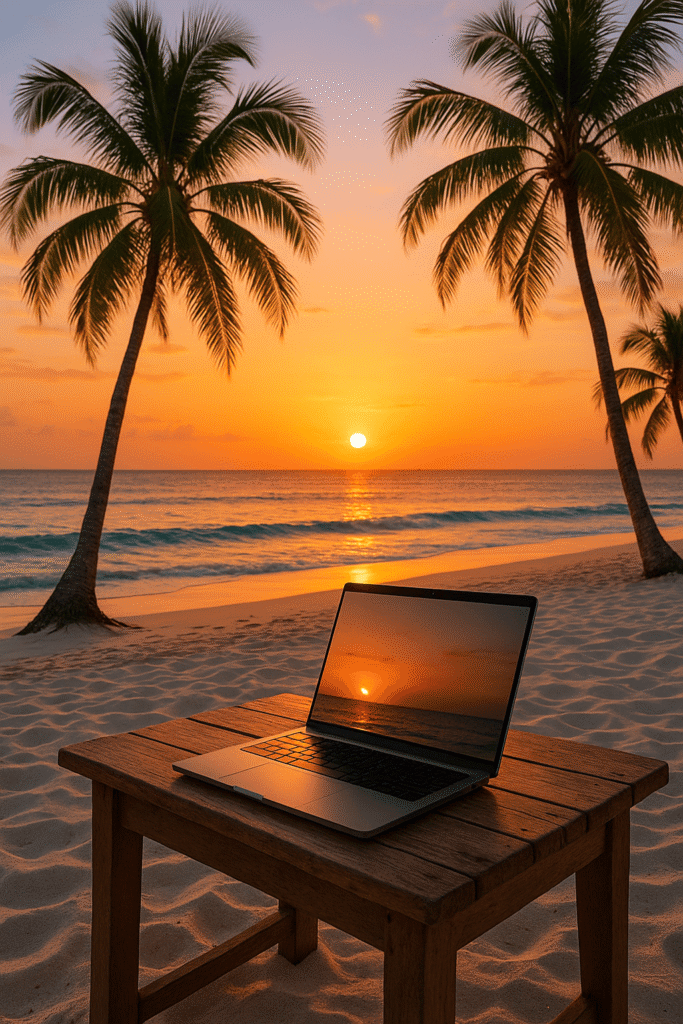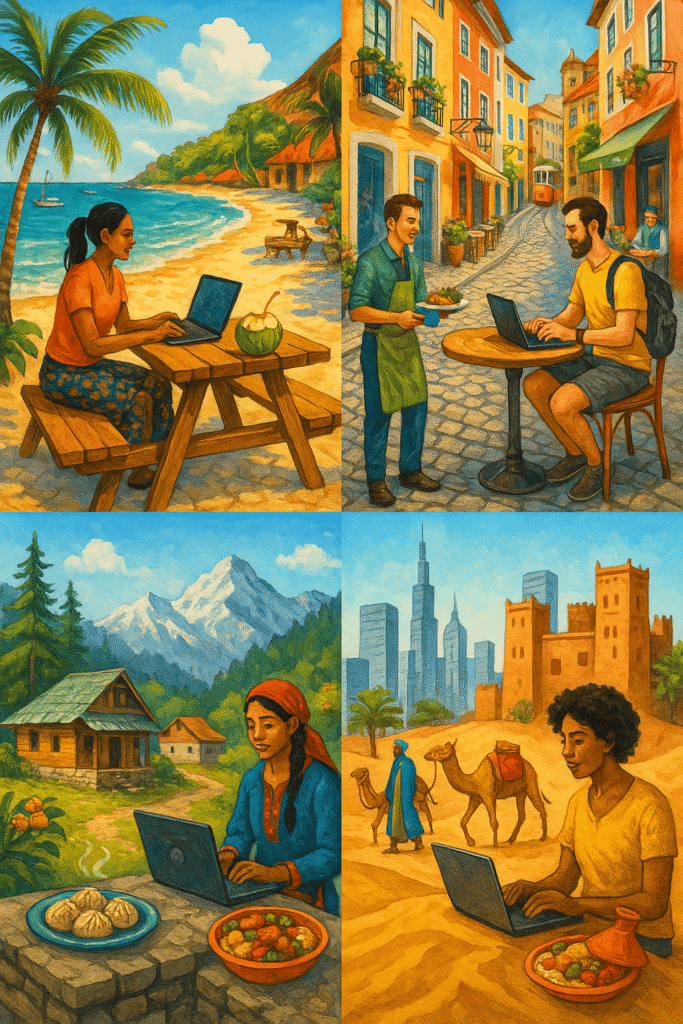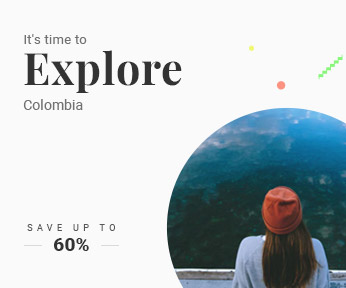
Picture this: It’s 7 AM, and instead of rushing to catch the subway to your cubicle, you’re sipping fresh coconut water while answering emails from a hammock in Bali. Three months ago, Sarah Martinez was trapped in a soul-crushing 9-to-5 in Chicago, dreaming of something more.
Today, she’s living proof that learning how to become a digital nomad in 2025 isn’t just a pipe dream—it’s an achievable reality that’s reshaping how we think about work and life balance.
The digital nomad lifestyle has exploded from a niche movement to a mainstream phenomenon, with over 10 million Americans now identifying as location-independent workers. If you’ve been scrolling through Instagram, watching those envy-inducing posts of people working from Santorini cafes or Lisbon co-working spaces, wondering if you could ever make that leap—this guide is your roadmap.
What Does It Really Mean to Become a Digital Nomad in 2025?
Being a digital nomad in 2025 goes far beyond the Instagram-worthy laptop-on-the-beach shots. It’s about building a sustainable, location-independent career that allows you to work from anywhere with reliable internet. Today’s digital nomads are remote software developers, content creators, online marketers, consultants, graphic designers, and even virtual assistants who’ve mastered the art of earning while exploring.
The landscape has evolved dramatically. Unlike the early nomad pioneers who struggled with spotty WiFi and limited visa options, 2025 offers unprecedented infrastructure, government support through digital nomad visas, and a thriving global community ready to welcome newcomers.

Step 1: Develop Your Digital Nomad Skills
High-Demand Remote Skills for 2025
Before you can master how to become a digital nomad in 2025, you need marketable skills that translate across borders. The most in-demand remote skills include:
Technology & Development:
- Web development (JavaScript, Python, React)
- Mobile app development
- UX/UI design
- Cybersecurity
- Data analysis and AI/ML
Creative & Marketing:
- Content writing and copywriting
- Social media management
- Graphic design and video editing
- SEO and digital marketing
- Photography and videography
Business & Consulting:
- Virtual assistance
- Project management
- Online coaching and consulting
- E-commerce management
- Financial planning and accounting
The key is choosing skills that align with your interests and have strong market demand. According to Upwork’s Global Talent Report, these skills consistently command higher rates and offer more flexibility.
Building Your Skill Set
Start by assessing your current abilities and identifying gaps. Platforms like Coursera, Udemy, and LinkedIn Learning offer comprehensive courses. However, the real magic happens when you start building a portfolio and gaining practical experience.
Consider taking on freelance projects while still employed, volunteering your skills for nonprofits, or creating personal projects that showcase your abilities. This approach helped Marcus Chen transition from accountant to successful digital marketing consultant within eight months.
Step 2: Establish Multiple Income Streams
The Foundation of Nomadic Financial Freedom
Learning how to become a digital nomad in 2025 requires understanding that successful nomads rarely rely on a single income source. Diversification is your safety net against market fluctuations and client dependencies.
Primary Income Streams:
- Full-time remote employment
- Freelance client work
- Online course creation
- Affiliate marketing
- Digital product sales
Passive Income Opportunities:
- Blog monetization
- YouTube channel revenue
- Stock photography
- App development
- Investment portfolios
The goal is creating what I call “nomad-proof income”—earnings that continue flowing regardless of your location or time zone. This might mean front-loading work during certain months or building systems that generate revenue while you sleep.
Financial Planning Essentials
Before taking the leap, establish an emergency fund covering 6-12 months of expenses. Factor in the higher costs of nomadic life—travel insurance, visa fees, accommodation flexibility, and currency fluctuations can add up quickly.
Use tools like Mint or YNAB to track expenses across different countries. Many successful nomads recommend the 50/30/20 rule: 50% for necessities, 30% for discretionary spending, and 20% for savings and investments.
Step 3: Choose Your Nomad-Friendly Destinations
Top Digital Nomad Destinations for 2025
Selecting the right destinations is crucial when figuring out how to become a digital nomad in 2025. The best nomad cities combine affordable living costs, reliable internet, vibrant communities, and reasonable visa policies.
Established Favorites:
- Lisbon, Portugal: Digital nomad visa, excellent infrastructure, thriving startup scene
- Mexico City, Mexico: No visa required for many nationalities, incredible food culture, strong peso value
- Bali, Indonesia: B211A visa, tropical paradise, established nomad community
- Prague, Czech Republic: Central European charm, affordable living, rich history
Emerging Hotspots:
- Tbilisi, Georgia: 365-day visa-free policy, extremely affordable, growing tech scene
- Dubai, UAE: One-year remote work visa, luxury amenities, tax advantages
- Medellín, Colombia: Year-round spring weather, co-working culture, affordable luxury
Research visa requirements, cost of living, internet speeds, and safety ratings before committing. Websites like Nomad List provide real-time data from the nomad community, while Lonely Planet offers comprehensive destination guides.

Step 4: Build Your Nomadic Toolkit
Essential Technology and Apps
Success in learning how to become a digital nomad in 2025 heavily depends on having the right tools and technology stack.
Hardware Essentials:
- Lightweight, powerful laptop (MacBook Air M2 or equivalent)
- Noise-canceling headphones
- Portable chargers and universal adapters
- Reliable smartphone with dual SIM capability
- Compact travel router for WiFi backup
Software Stack:
- Communication: Slack, Zoom, WhatsApp
- Project Management: Asana, Trello, Notion
- File Storage: Google Drive, Dropbox
- VPN: ExpressVPN, NordVPN for security
- Finance: Wise (formerly TransferWise), Revolut for multi-currency banking
Nomad-Specific Apps:
- Airbnb and Booking.com for accommodation
- Google Translate for language barriers
- Maps.me for offline navigation
- XE Currency for exchange rates
Step 5: Legal and Practical Considerations
Visas and Legal Requirements
Understanding visa requirements is non-negotiable when learning how to become a digital nomad in 2025. Many countries now offer specific digital nomad visas with varying requirements and benefits.
Popular nomad visas include Portugal’s D7, Estonia’s Digital Nomad Visa, and Barbados’ Welcome Stamp. Research requirements early, as applications can take months to process.
Insurance and Healthcare
Comprehensive travel insurance isn’t optional—it’s essential. Look for coverage including medical emergencies, equipment protection, and trip interruption. Companies like World Nomads and SafetyWing specialize in nomad-friendly policies.
Consider healthcare requirements in destination countries. Some require proof of insurance for visa applications, while others mandate specific coverage amounts.
Making the Transition: Your Action Plan
The 90-Day Launch Strategy
Days 1-30: Foundation Building
- Assess current skills and identify development areas
- Start building income streams while employed
- Research initial destinations and visa requirements
- Begin decluttering possessions
Days 31-60: Skill Development and Testing
- Complete relevant courses and certifications
- Take on freelance projects to test remote work capabilities
- Apply for necessary visas and documents
- Set up nomad-friendly banking and insurance
Days 61-90: Final Preparations
- Secure remote work arrangements or sufficient freelance contracts
- Book initial accommodation and travel
- Notify relevant parties of address changes
- Create backup plans for potential challenges
The key to successfully learning how to become a digital nomad in 2025 is methodical preparation combined with flexibility. Start small—perhaps a month-long trial in a nearby country—before committing to longer-term nomadism.
Frequently Asked Questions
Q: How much money do I need to become a digital nomad in 2025? A: The amount varies greatly by destination and lifestyle preferences. Budget nomads can survive on $1,000-1,500 monthly in countries like Vietnam or Guatemala, while those preferring Western Europe might need $3,000-4,000. Most experts recommend having 6-12 months of expenses saved before starting.
Q: Can I become a digital nomad without technical skills? A: Absolutely! While tech skills are in high demand, many successful nomads work in writing, marketing, design, consulting, virtual assistance, and online education. The key is developing skills that can be delivered remotely and have strong market demand.
Q: How do I handle taxes as a digital nomad? A: Tax obligations depend on your citizenship and residence status. US citizens must file annually regardless of location, while other nationals may establish tax residency elsewhere. Consult with tax professionals familiar with nomad situations, as rules are complex and constantly evolving.
Q: Is the digital nomad lifestyle sustainable long-term? A: Many nomads successfully maintain this lifestyle for years, though needs often evolve. Some settle in favorite destinations, others return home periodically, and many find hybrid approaches combining travel with home bases. The key is building systems that support your personal and professional goals.
Ready to Transform Your Life?
Learning how to become a digital nomad in 2025 isn’t just about escaping the 9-to-5 grind—it’s about designing a life that aligns with your values, curiosity, and desire for growth. The path requires dedication, planning, and sometimes uncomfortable leaps of faith, but the rewards extend far beyond Instagram-worthy photos.
The world has never been more accessible to location-independent workers. With proper preparation, marketable skills, and realistic expectations, you can join the millions who’ve discovered that home isn’t a place—it’s wherever you choose to be.
Ready to start your nomadic journey? Download our free “Digital Nomad Starter Kit” containing checklists, budget templates, and destination guides to fast-track your transition. Plus, join our community of aspiring and experienced nomads sharing real experiences, challenges, and victories.
What’s holding you back from making the leap? Share your biggest concern or question in the comments below—our community is here to help!







